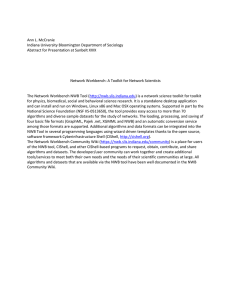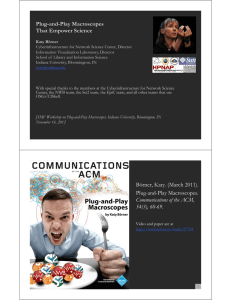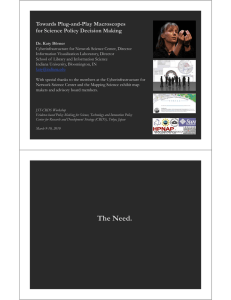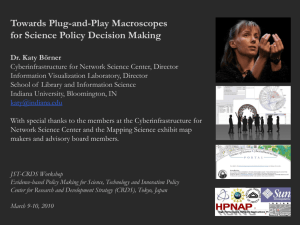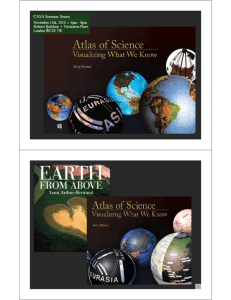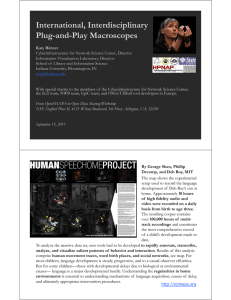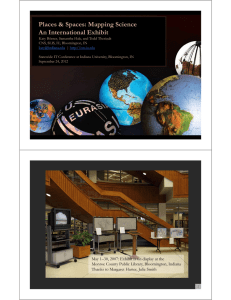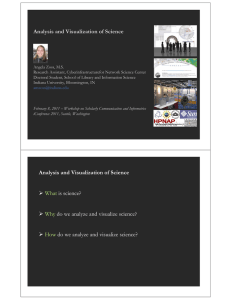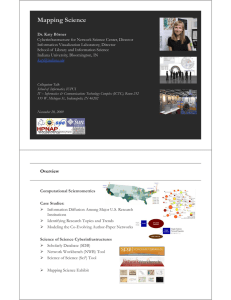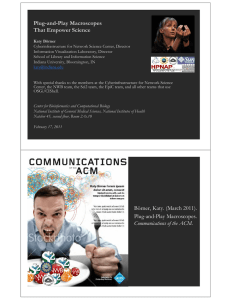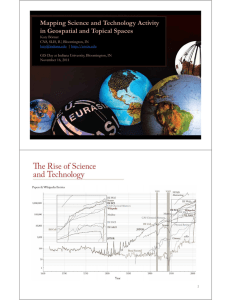Plug-and-Play Macroscopes
advertisement
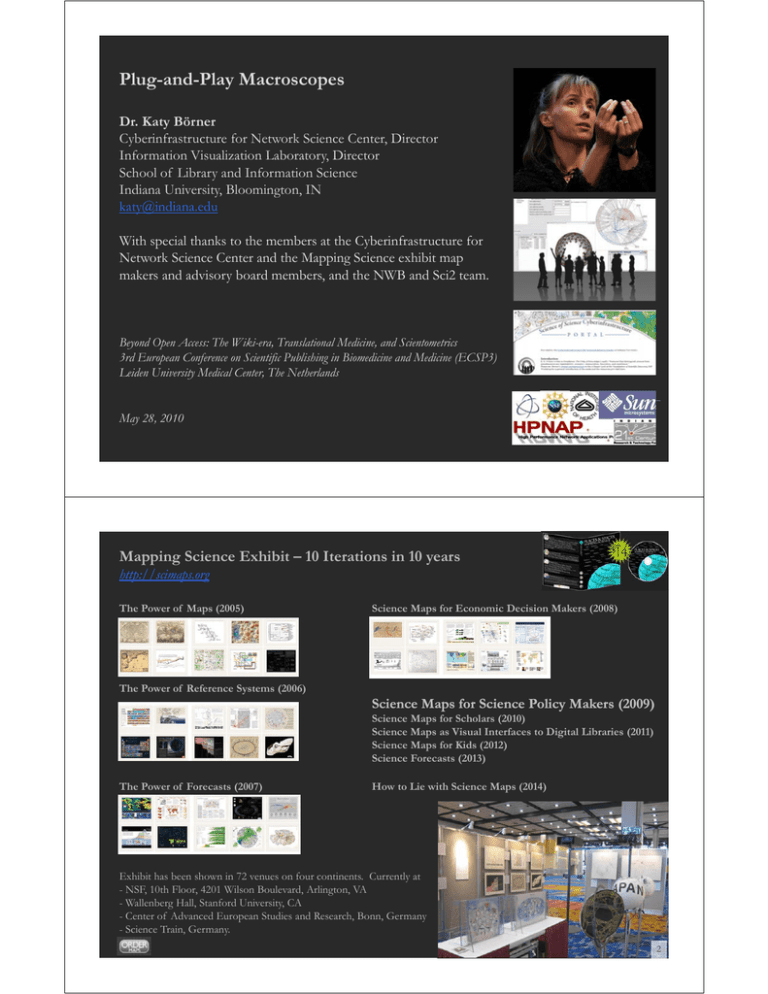
Plug-and-Play Macroscopes Dr. Katy Börner Cyberinfrastructure for Network Science Center, Director Information Visualization Laboratory Laboratory, Director School of Library and Information Science Indiana University, Bloomington, IN katy@indiana.edu With special thanks to the members at the Cyberinfrastructure for Network Science Center and the Mapping Science exhibit map makers and advisory board members, and the NWB and Sci2 team. Beyondd Open B Op A Access: Th The Wiki Wiki-era, Translational T l ti l M Medicine, di i andd SScientometrics i t ti 3rd European Conference on Scientific Publishing in Biomedicine and Medicine (ECSP3) Leiden University Medical Center, The Netherlands May 28, 2010 Mapping Science Exhibit – 10 Iterations in 10 years http://scimaps.org The Power of Maps (2005) Science Maps for Economic Decision Makers (2008) The Power of Reference Systems (2006) Science Maps for Science Policy Makers (2009) Science Maps for Scholars (2010) Science Maps as Visual Interfaces to Digital Libraries (2011) Science Maps for Kids (2012) Science Forecasts (2013) The Power of Forecasts (2007) How to Lie with Science Maps (2014) Exhibit has been shown in 72 venues on four continents. Currently at - NSF, 10th Floor, 4201 Wilson Boulevard, Arlington, VA - Wallenberg Hall, Stanford University, CA - Center of Advanced European Studies and Research, Bonn, Germany - Science Train, Germany. 2 Bollen, Johan, Herbert Van de Sompel, Aric Hagberg, Luis M.A. Bettencourt, Ryan Chute, Marko A. Rodriquez, Lyudmila Balakireva. 2008. A Clickstream Map of Science. 4 Council for Chemical Research. 2009. Chemical R&D Powers the U.S. Innovation Engine. Washington, DC. Courtesy of the Council for Chemical Research. 5 Debut D b off 5th Iteration I i off Mapping M i SScience i E Exhibit hibi at MEDIA X was on M May 18 18, 2009 at W Wallenberg ll b H Hall, ll Stanford University, http://mediax.stanford.edu, http://scaleindependentthought.typepad.com/photos/scimaps 6 Science Maps in “Expedition Expedition Zukunft” Zukunft science train visiting 62 cities in 7 months 12 coaches, 300 m long Opening was on April 23rd, 2009 by German Chancellor Merkel http://www.expedition-zukunft.de The Changing Scientific Landscape Star Scientist -> Research Teams: In former times, science was driven by key scientists. Today, T d science is driven d by b effectively ff l collaborating ll b co-author h teams often f comprising expertise from multiple disciplines and several geospatial locations (Börner, Dall'Asta, Ke, & Vespignani, 2005; Shneiderman, 2008). Users -> Contributors: Web 2.0 technologies empower anybody to contribute to Wiki di or to Wikipedia t exchange h images i andd videos id via i Fickr Fi k andd YouTube. Y T b WikiSpecies, WikiS i WikiProfessionals, or WikiProteins combine wiki and semantic technology in support of real time community annotation of scientific datasets (Mons et al., 2008). Cross-disciplinary: The best tools frequently borrow and synergistically combine methods and techniques from different disciplines of science and empower interdisciplinary and/or international teams of researchers, practitioners, or educators to fine-tune and interpret results collectively. One Specimen -> Data Streams: Microscopes and telescopes were originally used to study one specimen at a time. Today, many researchers must make sense of massive streams of multiple types of data with different formats, dynamics, and origin. Static Instrument -> Evolving Cyberinfrastructure (CI): The importance of hardware instruments that are rather static and expensive decreases relative to software infrastructures that are highly g y flexible and continuouslyy evolvingg accordingg to the needs of different sciences. Some of the most successful services and tools are decentralized increasing scalability and fault tolerance. 7 Microscopes, Telescopes, and Macrocopes Just as the microscope empowered our naked eyes to see cells, microbes, and viruses thereby advancing the progress of biology and medicine or the telescope opened our minds to the immensity of the cosmos and has prepared mankind for the conquest of space, macroscopes promise to help us cope with another infinite: the infinitely complex. Macroscopes give us a ‘vision of the whole’ and help us ‘synthesize’. They let us detect patterns, trends, outliers, and access details in the landscape of science. Instead of making things larger or smaller, smaller macroscopes let us observe what is at once too great, great too slow, slow or too complex for our eyes. Desirable Features of Macroscopes Core Architecture & Plugins/Division of Labor: Computer scientists need to design the h standardized, d d d modular, d l easy to maintain and d extend d “core architecture”. h Dataset and algorithm plugins, i.e., the “filling”, are provided by those that care and know most about the data and developed the algorithms: the domain experts. Ease of Use: As most plugin contributions and usage will come from non-computer scientists i ti t it mustt be b possible ibl to t contribute, t ib t share, h andd use new plugins l i without ith t writing iti one line of code. Users need guidance for constructing effective workflows from 100+ continuously changing plugins. Modularity: The design of software modules with well defined functionality that can be flexibly combined helps reduce costs costs, makes it possible to have many contribute, contribute and increases flexibility in tool development, augmentation, and customization. Standardization: Adoption of (industry) standards speeds up development as existing code can be leveraged. It helps pool resources, supports interoperability, but also eases the migration from research code to production code and hence the transfer of research results into industry applications and products. Open Data and Open Code: Lets anybody check, improve, or repurpose code and eases the replication of scientific studies. Börner, Katy (in press) Plug-and-Play Macroscopes. Communications of the ACM. Example: Science of Science Studies About 5-20 algorithms are involved in one single study/workflow. , Topics Börner, Katy, Chen, Chaomei, and Boyack, Kevin. (2003) Visualizing Knowledge Domains. ARIST, pp. 179-255. Domain has about 300 core researchers, 10 key data sources, 20 common tools. Approaches/algorithms from network science, social science, political science, economics, physics, information science, webometrics, etc. are highly relevant and new ones become available every day. 2002 Base Map of Science Kevin W. Boyack, Katy Börner, & Richard Klavans (2007). Mapping the Structure and Evolution of Chemistry Research. 11th IInternational t ti l C Conference f on SScientometrics i t t i andd IInformetrics. f t i pp pp. 112-123. 112 123 Uses combined SCI/SSCI from 2002 • 1.07M papers, 24.5M references, 7,300 journals • Bibliographic coupling of p p r aggregated papers, r t d tto journals Initial ordination and clustering of journals gave 671 clusters Coupling counts were reaggregated at the journal cluster level to calculate the • (x,y) positions for each journal cluster • by association, (x,y) positions ii for f each h jjournall Math Law Policy Computer Tech Statistics Economics Education CompSci Vision Phys-Chem Chemistry Physics Psychology Brain Environment Psychiatry GeoScience MRI Biology BioMaterials BioChem Microbiology Pl t Plant Cancer Animal Disease & Treatments Virology Infectious Diseases Science map applications: Identifying core competency Kevin W. Boyack, Katy Börner, & Richard Klavans (2007). Funding patterns of the US Department of Energy (DOE) Math Law Computer Tech Policy Statistics Economics CompSci Vision Education Phys-Chem Chemistry Physics Psychology Brain Environment GeoScience Psychiatry MRI Biology GI BioBi Materials BioChem Microbiology Plant Cancer Animal Virology Infectious Diseases Science map applications: Identifying core competency Kevin W. Boyack, Katy Börner, & Richard Klavans (2007). Funding Patterns of the National Science Foundation (NSF) Math Law Computer Tech Policy Statistics Economics CompSci Vision Education Phys-Chem Chemistry Physics Psychology Brain Environment Psychiatry GeoScience MRI Biology GI BioBi Materials BioChem Microbiology Plant Cancer Animal Virology Infectious Diseases Science map applications: Identifying core competency Kevin W. Boyack, Katy Börner, & Richard Klavans (2007). Funding Patterns of the National Institutes of Health (NIH) Math Law Computer Tech Policy Statistics Economics CompSci Vision Education Phys-Chem Chemistry Physics Psychology Brain Environment Psychiatry GeoScience MRI Biology GI BioBi Materials BioChem Microbiology Plant Cancer Animal Virology Infectious Diseases Macroscope Design Custom Tools for Different Scientific Communities Information Visualization Cyberinfrastructure http://iv.slis.indiana.edu Network Workbench Tool + Community Wiki http://nwb.slis.indiana.edu Science of Science ((Sci2) Tool and d Portal http://sci.slis.indiana.edu Epidemics Cyberinfrastructure http://epic.slis.indiana.edu/ 180+ Algorithm Plugins and Branded GUIs + Core Architecture Open Services Gateway Initiative (OSGi) Framework. http://orgi.org Cyberinfrastructure Shell (CIShell) http://cishell org http://cishell.org 16 Cyberinfrastructure Shell (CIShell) http://cishell.org CIShell is an open source software specification for the integration and utilization of datasets, algorithms, and tools. It I extends d the h O Open SServices i G Gateway IInitiative i i i (OSGi) (http://www.osgi.org), (h // i ) a standardized, component oriented, computing environment for networked services widely used in industry since 10 years. Specifically, Specifically CIShell provides “sockets” sockets into which existing and new datasets datasets, algorithms, and tools can be plugged using a wizard-driven process. Developers Users CIShell Wizards CIShell IV Tool NWB Interface 17 Network Workbench Tool p http://nwb.slis.indiana.edu The Network Workbench ((NWB)) tool supports researchers, educators, and practitioners interested in the study of biomedical, social and behavioral science, physics, and other networks. In February 2009, the tool provides more 169 plugins that support the preprocessing, analysis, modeling, and visualization of networks. More than 50 of these plugins can be applied or were specifically designed for S&T studies. It has been downloaded more than 65,000 times since December 2006. Herr II, Bruce W., Huang, Weixia (Bonnie), Penumarthy, Shashikant & Börner, Katy. (2007). Designing Highly Flexible and Usable Cyberinfrastructures for Convergence. In Bainbridge, William S. & Roco, Mihail C. (Eds.), Progress in Convergence - Technologies for Human Wellbeing (Vol. 1093, pp. 161-179), Annals of the New York Academy of Sciences, Boston, MA. 18 Computational Proteomics What relationships exist between protein targets of all drugs and all disease-gene products in the human protein–protein interaction network? Yildriim, Muhammed A., Kwan-II Goh, Michael E. E Cusick, Cusick Albert-László Barabási, and Marc Vidal. (2007). Drug-target g g Network. Nature Biotechnology 25 no. 10: 1119-1126. 19 Computational Economics yp of product p that a Does the type country exports matter for subsequent economic performance? C. A C A. Hidalgo Hidalgo, B B. Klinger Klinger, A.-L. Barabási, R. Hausmann (2007) The Product Space Conditions the Development of Nations. Science 317, 482 (2007). 20 Computational Social Science Studying large scale social networks such as Wikipedia Second Sight: An Emergent Mosaic of Wikipedian Activity, The NewScientist, May 19, 2007 Computational Epidemics Forecasting (and preventing the effects of) the next pandemic. Epidemic Modeling in Complex realities, V. Colizza, A. Barrat, M. Barthelemy, A.Vespignani, Comptes Rendus Biologie, 330, 364-374 (2007). Reaction-diffusion Reaction diffusion processes and metapopulation models in heterogeneous networks, V.Colizza, R. Pastor Pastor-Satorras, Satorras, A.Vespignani, Nature Physics 3, 276-282 (2007). Modeling the Worldwide Spread of Pandemic Influenza: Baseline Case and Containment Interventions, V. Colizza, A. Barrat, M. Barthelemy, A.-J. Valleron, A.Vespignani, PloS-Medicine PloS Medicine 4, e13, 95 95-110 110 (2007). NWB Tool Interface Components Console shows references to seminal works. Workflows are recorded into a log file, and soon can be re-run for easy replication. All algorithms are documented online; workflows are given in tutorials. 23 NWB Tool: Supported Data Formats Personal Bibliographies Bibtex (.bib) Endnote Export Format (.enw) Data Providers Web of Science by Thomson Scientific/Reuters (.isi) Scopus by Elsevier ((.scopus) scopus) Google Scholar (access via Publish or Perish save as CSV, Bibtex, EndNote) Awards Search by National Science Foundation (.nsf) Scholarly Database (all text files are saved as .csv) Medline publications by National Library of Medicine NIH funding awards by the National Institutes of Health (NIH) NSF funding awards by the National Science Foundation (NSF) U.S. patents by the United States Patent and Trademark Office (USPTO) Medline papers – NIH Funding Network Formats NWB (.nwb) Pajek (.net) GraphML (.xml or .graphml) XGMML (.xml) Burst Analysis Format Burst (.burst) Other O h Formats F CSV (.csv) Edgelist (.edge) Pajek (.mat) TreeML T ML (.xml) ( l) 24 NWB Tool: Algorithms (July 1st, 2008) See https://nwb.slis.indiana.edu/community and handout for details. 25 25 NWB Tool: Output Formats NWB tool can be used for data conversion. Supported output formats comprise: CSV (.csv) ( ) NWB (.nwb) Pajek (.net) Pajek (.mat) ( mat) GraphML (.xml or .graphml) XGMML (.xml) GUESS Supports pp export p of images g into common image file formats. Horizontal Bar Graphs saves out raster and ps files. 26 Science of Science (Sci2) Tool http://sci.slis.indiana.edu Explicitly designed for SoS research and practice, well documented, easy to use. Empowers E many to run common studies di while hil making ki iit easy ffor exports to perform novel research. Advanced algorithms, effective visualizations, and many (standard) workflows. Supports micro-level documentation and replication of studies. Is open source—anybody can review and extend the code, or use it for commercial purposes. 27 27 Sci2 Tool – “Open Code for S&T Assessment” OSGi/CIShell powered tool with NWB plugins and manyy new scientometrics and visualizations plugins. p g Sci Maps GUESS Network Vis Horizontal Time Graphs Börner, Katy, Huang, Weixia (Bonnie), Linnemeier, Micah, Duhon, Russell Jackson, Phillips, Patrick, Ma, Nianli, Zoss, Angela, Guo, Hanning & Price, Mark. (2009). Rete-Netzwerk-Red: Analyzing and Visualizing Scholarly Networks Using the Scholarly Database and the Network Workbench Tool. Proceedings of ISSI 2009: 12th International Conference on Scientometrics and Informetrics, Rio de Janeiro, Brazil, July 14-17 . Vol. 2, pp. 619-630. Sci2 Tool Geo Maps Circular Hierarchy Sci2 Tool: Algorithms See https://nwb.slis.indiana.edu/community Preprocessing Modeling Extract Top N% Records Extract Top N Records Normalize Text Slice Table by Line --------------------------------------------Extract Top Nodes Extract Nodes Above or Below Value Delete Isolates --------------------------------------------Extract top Edges Extract Edges Above or Below Value Remove Self Loops Trim by Degree MST Pathfinder Network Scaling MST-Pathfinder Fast Pathfinder Network Scaling --------------------------------------------Snowball Sampling (in nodes) Node Sampling Edge g Sampling p g --------------------------------------------Symmetrize Dichotomize Multipartite Joining --------------------------------------------G Geocoder d --------------------------------------------Extract ZIP Code Random Graph Watts-Strogatz Small World Barabási-Albert Scale-Free TARL Analysis Network Analysis Toolkit (NAT) Unweighted & Undirected Node Degree Degree Distribution --------------------------------------------K-Nearest Neighbor (Java) Watts Strogatz Clustering Coefficient Watts-Strogatz Watts Strogatz Clustering Coefficient over K --------------------------------------------Diameter Average Shortest Path Shortest Path Distribution Node Betweenness Centrality --------------------------------------------Weak Component Clustering Global Connected Components --------------------------------------------Extract K-Core C Annotate K-Coreness --------------------------------------------HITS Weighted & Undirected Clustering Coefficient Nearest Neighbor Degree Strength g vs Degree g Degree & Strength Average Weight vs End-point Degree Strength Distribution Weight Distribution Randomize Weights --------------------------------------------Blondel Community Detection --------------------------------------------HITS Unweighted & Directed Node Indegree Node Outdegree Indegree Distribution Outdegree Distribution --------------------------------------------K-Nearest Neighbor Single Node in-Out Degree Correlations --------------------------------------------Dyad Reciprocity Arc Reciprocity Adjacency Transitivity --------------------------------------------Weak Component Clustering Strong Component Clustering --------------------------------------------30 Sci2 Tool: Algorithms cont. See https://nwb.slis.indiana.edu/community -------------------------------Extract K-Core Annotate K K-Coreness Coreness -------------------------------HITS PageRank Weighted & Directed HITS Weighted PageRank Textual Burst Detection NEW: Database support for ISI and NSF data. Visualization Scientometrics GnuPlot GUESS Image Viewer --------------------------------------------Radial Tree/Graph (prefuse alpha) Radial Tree/Graph with Annotation (prefuse beta) T View Tree Vi ((prefuse f beta) b ) Tree Map (prefuse beta) Force Directed with Annotation (prefuse beta) Fruchterman-Reingold with Annotation (prefuse beta) --------------------------------------------DrL (VxOrd) Specified (prefuse beta) --------------------------------------------Horizontal Line Graph Circular Hierarchy Geo Map (Circle Annotation Style) Geo Map (Colored-Region Annotation Style) *Science Map (Circle Annotation) Remove ISI Duplicate Records Remove Rows with Multitudinous Fields Detect Duplicate Nodes Update Network by Merging Nodes --------------------------------------------Extract Directed Network Extract Paper Citation Network E Extract A Author h P Paper N Networkk --------------------------------------------Extract Co-Occurrence Network Extract Word Co-Occurrence Network Extract Co-Author Network Extract Reference Co Co-Occurrence Occurrence (Bibliographic Coupling) Network --------------------------------------------Extract Document Co-Citation Network * Requires permission from UCSD All four+ save into Postscript files. Automatic legends. 31 Mapping Transdisciplinary Tobacco Use Research Centers Publications C Compare R01 investigator i i based b d funding f di with i h TTURC Center awards in terms of number of publications and evolving co-author networks. Z & Börner, Zoss Bö forthcoming. f th i Interactive Science Map of NIH Funding Herr II, Bruce W., Talley, Edmund M, Burns, Gully APC, Newman, David & La Rowe, Gavin. (2009). http://scimaps.org/maps/nih/2007 Where Are the Academic Jobs? Interactive Exploration of Job Advertisements in Geospatial and Topical Space Angela Zoss, Michael Connover, Katy Börner (2010) http://cns-nd3.slis.indiana.edu/mapjobs/geo 34 Computational Scientometrics References Börner, Katy, Chen, Chaomei, and Boyack, Kevin. (2003). Visualizing Knowledge Domains. In Blaise Cronin (Ed ) ARIST, (Ed.), ARIST Medford, Medford NJ: Information Today, Today Inc./American Society for Information Science and Technology, Volume 37, Chapter 5, pp. 179-255. http://ivl.slis.indiana.edu/km/pub/2003-borner-arist.pdf Shiffrin, Richard M. and Börner, Katy (Eds.) (2004). Mapping Knowledge Domains. Proceedings of the National Academy of Sciences of the United States of America, 101(Suppl_1). http://www pnas org/content/vol101/suppl 1/ http://www.pnas.org/content/vol101/suppl_1/ Börner, Katy, Sanyal, Soma and Vespignani, Alessandro (2007). Network Science. In Blaise Cronin (Ed.), ARIST, Information Today, d y, Inc./American / Societyy for Information Science and Technology, Medford, NJ, Volume 41, Chapter 12, pp. 537-607. http://ivl.slis.indiana.edu/km/pub/2007-borner-arist.pdf Börner, Katy (2010) Atlas of Science. MIT Press. http://scimaps.org/atlas 35 Discussion and Outlook A number of other projects recently adopted OSGi and one adopted CIShell: C Cytoscape (h // (http://www.cytoscape.org) ) lead l d by b Trey T Ideker, Id k UCSD iis an open source bioinformatics software platform for visualizing molecular interaction networks and integrating these interactions with gene expression profiles and other state data (Shannon et al., 2002). Taverna Workbench (http://taverna.sourceforge.net) (http://taverna sourceforge net) lead by Carol Goble Goble, University of Manchester, UK is a free software tool for designing and executing workflows (Hull et al., 2006). Taverna allows users to integrate many different software tools, including over 30,000 web services. MAEviz (https://wiki.ncsa.uiuc.edu/display/MAE/Home) (https://wiki ncsa uiuc edu/display/MAE/Home) managed by Shawn Hampton Hampton, NCSA is an open-source, extensible software platform which supports seismic risk assessment based on the Mid-America Earthquake (MAE) Center research. TEXTrend (http://www.textrend.org) lead by George Kampis, Eötvös University, Hungary develops p a framework for the easyy and flexible integration, g , configuration, g , and extension of plugin-based components in support of natural language processing (NLP), classification/mining, and graph algorithms for the analysis of business and governmental text corpuses with an inherently temporal component. As the functionality of OSGi-based software frameworks improves and the number and diversity of dataset and algorithm plugins increases, the capabilities of custom tools will expand. Discussion & Outlook cont. Star Scientist -> Research Teams might have 100 or more members & exist few months only. U Users -> > Contributors C ib students, d ffaculty, l practitioners. ii Disciplinary -> Cross-disciplinary with different cultures, languages, approaches. One Specimen -> Data Streams updated nightly or even more frequently High g Quality Q y Open p Data Scholarly Database: 23 million scholarly records http://sdb.slis.indiana.edu VIVO National Researcher Networking http://vivo eb org http://vivoweb.org Static Instrument -> Evolving Cyberinfrastructure (CI) daily learning and documentation. Macroscopes can make a major difference if they support: Division of Labor – proper incentive structures are key. Ease of Use – learn from YouTube, Flickr, Wikipedia Modularity – plug-and-play helps reduce costs; increases flexibility, augmentation, customization Standardization – speeds up ‘translation’ translation into products/practice products/practice. Open Data and Open Code – use the minds of millions! All papers, maps, cyberinfrastructures, talks, press are linked from http://cns.slis.indiana.edu
